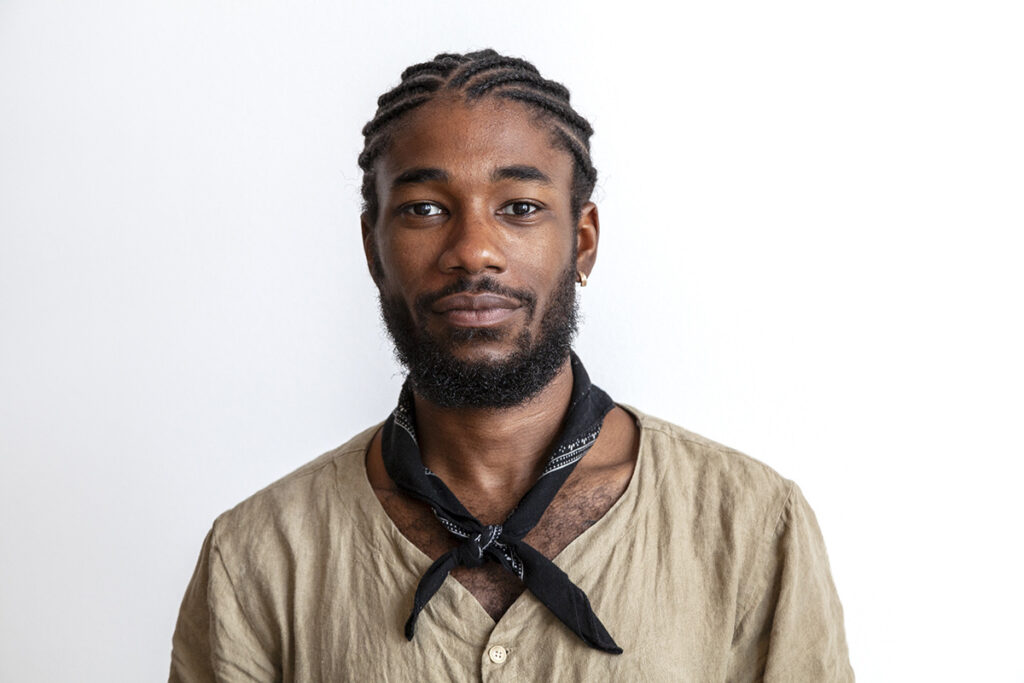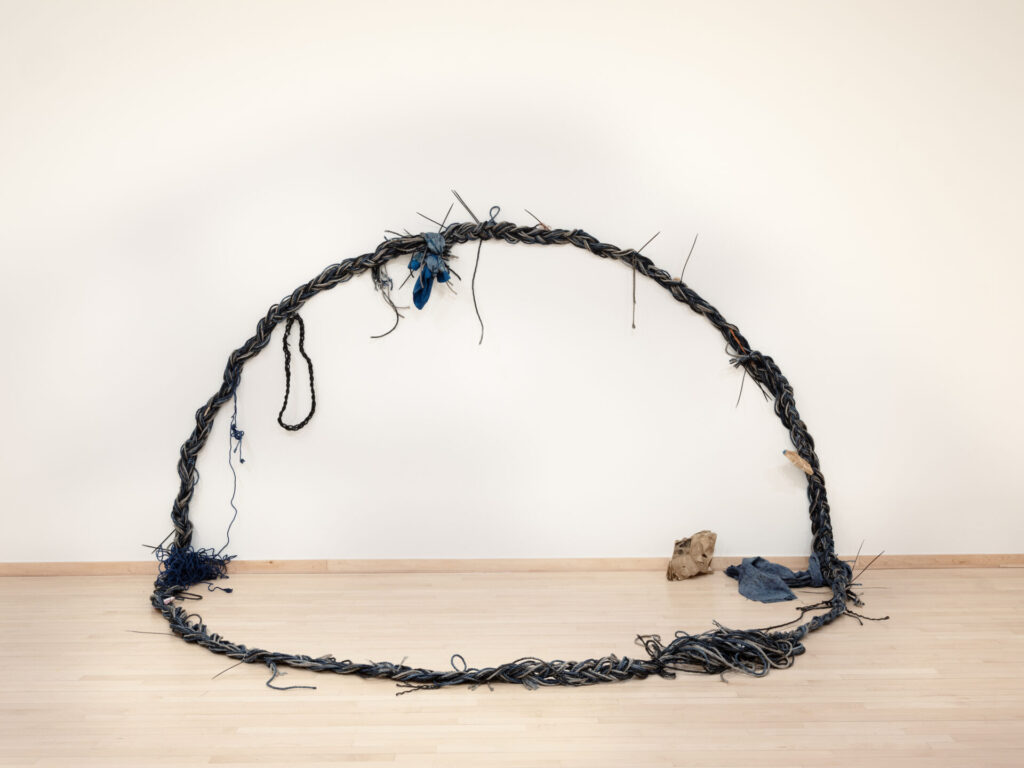For Sunday Visit, We are excited to sit down with the multi-hyphenate Ryan Scails. Based in Philadelphia, PA he examines the nuances of materiality within the built world and how intentional shifts in details can give humans context in ways that confront the limits of their bodies. By using fiber to create hyper specific structural relationships, his work highlights the potential in substantive engagements between the human body and our environment. In a manner that leans heavily on the sequential harmony of physical labor his work seeks to foreground pre-colonial technologies by riffing on fractured schematics, glyphs, and vernacular tools to sift through the imperial aggregate. His most recent exhibitions include To Prepare A Place For You at Temple Contemporary (Philadelphia, PA), Martin’s End at Tiger Strikes Asteroid (Philadelphia, PA), Graphite Stew at Upper Market Gallery (San Francisco, CA). Ryan has attended residencies at MASSMoCA, Textile Arts Center – Brooklyn, and the John Michael Kohler Arts Center Arts/Industry program.

Ryan, give us a little bit about your history, and how you arrived at your current practice. We first met through the Textile Arts Center, and worked together to do some natural dyeing. What initially drew you to the medium of natural dyes?
I’m originally from Connecticut, about an hour and a half north of New York City. As a young kid I played in the woods after school everyday and would find myself wandering through trails just loving the outdoors but not having any tangible knowledge of the ecology around me. I briefly studied Industrial Design for a few semesters and it reinforced my fascination with materiality. I’m very multidisciplinary and will genuinely make art out of anything, but fiber is a constant because there’s a type of immediacy in how I understand fabric and the means of fiber production. It’s one of the easiest ways I know to solve formal problems. When it comes to natural dyes, I’m intrigued by the ritualistic harvesting of materials. It just seems to make sense. There’s a lot of overlap, in my mind anyway, of the scientific and the mystical, and because of that it feels like a thoughtful way to work with color. There’s so much to learn and natural dyeing represents endless amounts of intercultural knowledge that’s been workshopped for generations.

There is such a visceral connection to the body and cloth in your work. Can you walk us through the process of how you create your pieces? Does the work evolve as you are creating it or do you set out with a specific idea you are realizing three-dimensionally?
Thank you, sometimes I feel like I really bounce around in terms of style, making incongruous objects instead of a steady series, but the body seems to show up consistently. I do a lot of drawing, it helps me to understand things spatially. My research will take me down a rabbit hole about a specific material, and then I’ll become obsessed about its different use histories. After some drawing and writing, what develops is always some sort of liberatory tool or set of tools. I’m a fan of mutable fabrics; things that can take dye or change easily. Cotton canvas, muslin, linen, wool; all of these have been processed for thousands of years so you can associate so much of the human experience with even the rawest forms of different fibers. The form of what I’m making is always subject to change. As I handle found objects or the things I create myself, supplies will get damaged so I’ve learned to find excitement in every iteration of the materials I work with. Ultimately, the type of objects I make tend to let me know when they’re done or have reached some sort of final form.


What draws you to exemplifying pre-colonial technologies in your work? Can you give us an example of how this manifests for you?
I’ll put it this way; I’m always eager to reference inventions or concepts that predate colonialism, and specifically capitalism, but I’m interested in technology overall. I feel like there’s a lot that we tend to miss as we experience advancement of any kind. Things left in the margins. I tend to spend more time studying the efficacy of things that are done with more holistic intentions. I like for my work to reflect an investment in stewardship because dealing with place and abundance is a very human thing. One of the pieces I made recently was a large sculpture called Ark; an abstract installation that represents the gesture of seed carrying. Which was when enslaved Africans, without any knowledge of where they were being sent, braided seeds into their hair and fastened them to necklaces before making the journey across the Atlantic.
I used tons of found synthetic rope and cord to create a large-scale braid that I pigmented (with Indigo, Black Walnut, and spray paint) and eventually formed in the shape of a wreath. It’s installed as a sort of bent circle, both on the wall and laying on the floor in front of the viewer. The rope was embellished with seed-like forms made from objects I gleaned from around Philadelphia. To me, pre-colonial technologies represent a more nuanced approach towards looking at the world. In this instance, seed carrying and braiding work hand-in-hand as an example of pre-colonial agricultural technology and I wanted to respond to that while thinking about the connections to our current ecology.

Outside of your artistic practice, what makes you tick?
I love music; I’ve been brushing up on music theory again to see if I have a better understanding of it at this stage in life. I was never a good sight reader! I also love sports, specifically soccer, or football, to most of the world. I’ve been playing for as long as I’ve been making art so it’s one of the things in my life that acts as a spiritual salve when I can find a game.

How does the medium of natural dyes make its way into your practice?
There’s an inherent logic to natural dyes and I’m all about using what’s readily available. The fewer moves the better. I love tannin rich dyes that do a lot on their own. For example, a couple years ago, I harvested some unripe American Persimmons from a tree here in Philly, with the hopes of making my own version of kakishibu. It’s an ongoing experiment that I hope to push further. Regarding tannins, one of my recent pieces is essentially a recontextualized cotton bath towel that acted as a barrier between a bucket of Black Walnuts and the trunk of the car transporting them. The towel is so thoroughly stained and representative of process that it looks like an unintentional rorschach test, but instead of ink black, the color is more akin to industrial brown. I really love seeing nature act upon the manufactured world, and leave traces of its mechanics.

What are you working on lately?
Right now I’m actually moving studios so I’ve been working on small objects; mainly wearables and accessories. I’ve been thinking about how to use some of the fabrics and objects I have in storage and since I’ve always loved jewelry as a medium, I’m starting with brooches.
Last song on your playlist, no cheating.
